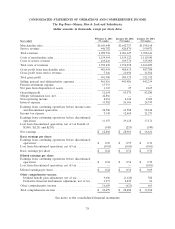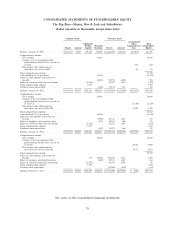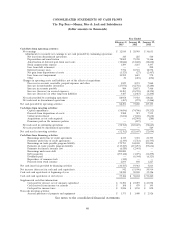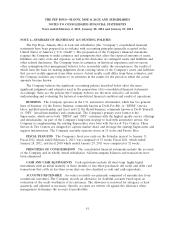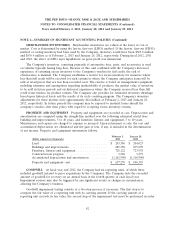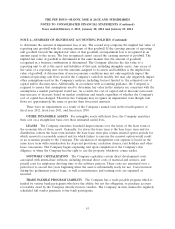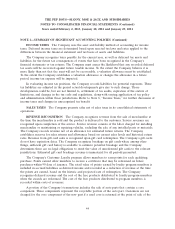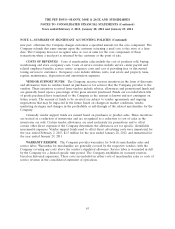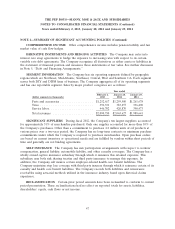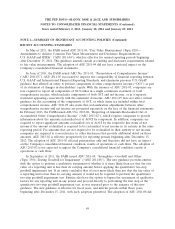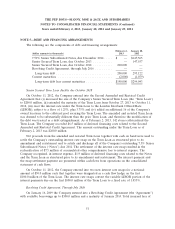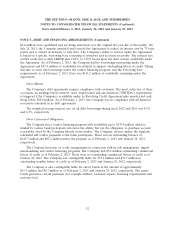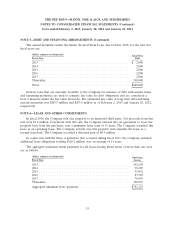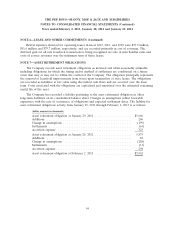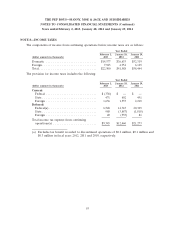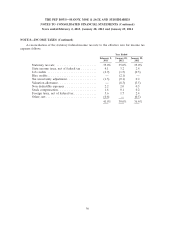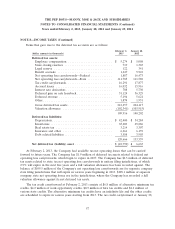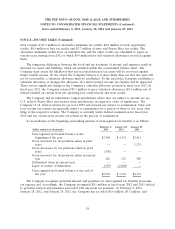Pep Boys 2012 Annual Report Download - page 87
Download and view the complete annual report
Please find page 87 of the 2012 Pep Boys annual report below. You can navigate through the pages in the report by either clicking on the pages listed below, or by using the keyword search tool below to find specific information within the annual report.THE PEP BOYS—MANNY, MOE & JACK AND SUBSIDIARIES
NOTES TO CONSOLIDATED FINANCIAL STATEMENTS (Continued)
Years ended February 2, 2013, January 28, 2012 and January 29, 2011
NOTE 1—SUMMARY OF SIGNIFICANT ACCOUNTING POLICIES (Continued)
RECENT ACCOUNTING STANDARDS
In May of 2011, the FASB issued ASU 2011-04, ‘‘Fair Value Measurement (Topic 820)—
Amendments to Achieve Common Fair Value Measurement and Disclosure Requirements in
U.S. GAAP and IFRSs’’ (‘‘ASU 2011-04’’), which is effective for annual reporting periods beginning
after December 15, 2011. This guidance amends certain accounting and disclosure requirements related
to fair value measurements. The adoption of ASU 2011-04 did not have a material impact on the
Company’s consolidated financial statements.
In June of 2011, the FASB issued ASU No. 2011-05, ‘‘Presentation of Comprehensive Income’’
(‘‘ASU 2011-05’’). ASU 2011-05 was issued to improve the comparability of financial reporting between
U.S. GAAP and International Financial Reporting Standards, and eliminates previous U.S. GAAP
guidance that allowed an entity to present components of other comprehensive income (‘‘OCI’’) as part
of its statement of changes in shareholders’ equity. With the issuance of ASU 2011-05, companies are
now required to report all components of OCI either in a single continuous statement of total
comprehensive income, which includes components of both OCI and net income, or in a separate
statement appearing consecutively with the statement of income. ASU 2011-05 does not affect current
guidance for the accounting of the components of OCI, or which items are included within total
comprehensive income. ASU 2011-05 also states that reclassification adjustments between other
comprehensive income and net income are presented separately on the face of the financial statements.
In February 2013, the FASB issued ASU No. 2013-02, ‘‘Reporting of Amounts Reclassified Out of
Accumulated Other Comprehensive Income’’ (‘‘ASU 2013-02’’), which requires companies to provide
information about the amounts reclassified out of AOCI by component. In addition, companies are
required to report significant amounts reclassified out of AOCI by the respective line items of net
income if the amount reclassified is required to be reclassified to net income in its entirety in the same
reporting period. For amounts that are not required to be reclassified in their entirety to net income,
companies are required to cross-reference to other disclosures that provide additional detail on those
amounts. ASU 2013-02 is effective prospectively for reporting periods beginning after December 15,
2012. The adoption of ASU 2011-05 affected presentation only and therefore did not have an impact
on the Company’s consolidated financial condition, results of operations or cash flows. The adoption of
ASU 2013-02 is not expected to impact the Company’s consolidated financial condition, results of
operations or cash flows.
In September of 2011, the FASB issued ASU 2011-08, ‘‘Intangibles—Goodwill and Other
(Topic 350)—Testing Goodwill for Impairment’’ (‘‘ASU 2011-08’’). The new guidance provides entities
with the option to perform a qualitative assessment of whether it is more likely than not that the fair
value of a reporting unit is less than its carrying amount before applying the quantitative two-step
goodwill impairment test. If an entity concludes that it is not more likely than not that the fair value of
a reporting unit is less than its carrying amount, it would not be required to perform the quantitative
two-step goodwill impairment test. Entities also have the option to bypass the assessment of qualitative
factors for any reporting unit in any period and proceed directly to performing the first step of the
quantitative two-step goodwill impairment test, as was required prior to the issuance of this new
guidance. The new guidance is effective for fiscal years, and interim periods within those years,
beginning after December 15, 2011, with early adoption permitted. The adoption of ASU 2011-08 did
48


